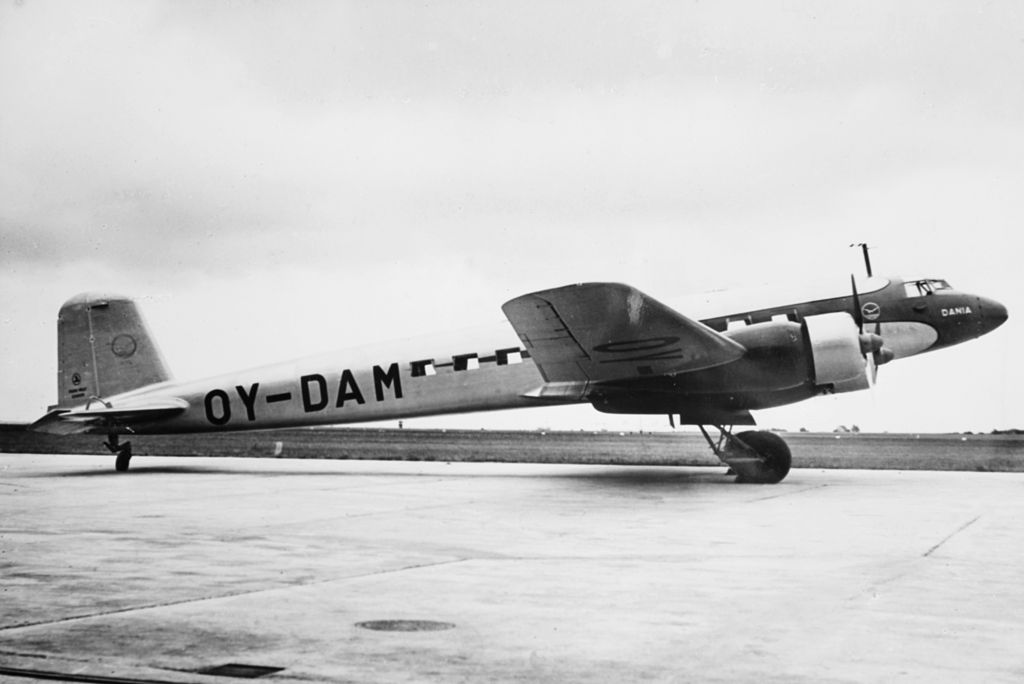Uffe Harald Jensen
(1903 - 1989)
Profile
Uffe Harald Jensen was a trained radio operator in Danish Airlines before the war. He was part of a crew landing in Shoreham on the eve of the German occupation. Unable to return to Denmark he served in BOAC and in the Royal Air Force during the war.
Uffe Harald Jensen was born on 11 August 1903 in Fjellevad. He is the son of veterinarian Anthon Jensen and Nielsine Rasmine Jensen.[1]
Jensen wanted to travel and see the world from an early age. After having finished school, he saw an advertisement calling for radio operators. He thought that this training was a way to be able to travel. And he was right. He was trained at the Tuxen’s radio school in Svendborg and got his certificate in 1923.
In 1924, he was employed by Svitzer’s safety-salvage company and he remained with this company until 1939. He was stationed in Frederikshavn for half a year, before being stationed in Constantinople and later Athens, Saloniki, Marseille and Suez.[2]

Danish Airlines
In 1939, while stationed in Egypt, Jensen applied for a position in Danish Airlines (Det danske Luftfartsselskab). He was employed as radio officer on 1 April 1939.[3]
On 8 April 1940, Danish Airlines’ Focke-Wulf Fw 200 Condor Dania took off from Copenhagen. The crew included pilot and captain Harald Julius Hansen, flight engineer Hans Jørgen Marius Dalbro, Jensen as radio officer and stewardesse Doris Augusta Marie Jensen. On their way to London, they observed a large number of German ships in Kattegat, the Great Belt and the North Sea in the direction of Norway.
The Condor landed in Shoreham near Brighton in the late afternoon and prepared to return the next day. However, at 0630 hrs., Harald Hansen telephoned Jensen in the hotel in Worthing, where they spent the night, and informed him that Denmark had been overrun by the Germans.[4] The aircraft seized as a prize of war by the British government.[5]
War Service
The crew was attached to British Overseas Aviation Corporation (BOAC) and moved to Bristol, where the company had its headquarters. Later, Jensen was transferred to the Royal Air Force. Jensen was involved in the evacuation of troops from Dunkirk and other parts of Northern France in 1940. All available aircraft—military and civilian—flew back and forth to bring back as many men as possible.
In 1942, he was stationed in East Africa. In 1941, AOC-in-C Lord Tedder had proposed a joint RAF-BOAC transport organisation to be established (the Tedder Plan). A new maintenance facility was set up in Asmara in Eritrea.[6] A number of routes were setup in the area operated with Lockheed Lodestars, for instance, Cairo-Wadi Halfa-Port Sudan-Asmara, Cairo-Habbaniya-Tehran (for contact with the Soviet Union), Cairo-Lydda-Adana and Asmara-Khartoum. During the following years routes were decided according to the ebb and flow of the war in Northern Africa.[7] Jensen was posted to Asmara initially, and later to Cairo. At one point, for instance, he was involved in supplying Malta—the island under siege—on a continuous basis.[8] It is not clear, if Jensen is referring to this operation, but in May 1942 a night service to Malta operated for a short time via forward airstrips.[9]
Jensen remained in the area until the end of the war. He is known to have spend Christmas with members of the British Eight Army near the front. This must have been in December 1942.[10]
Returning home
In May 1945 the war in Europe ended, but Jensen remained in Egypt for a while. In July 1945, in Cairo, he was approached by Danish Airlines’ general manager Knud Lybye and captain Emil Damm, who was in North Africa to inspect aircraft a number of American Douglas DC-3 aircraft for possible post-war airline operations.[11] They asked Jensen to consider returning to Denmark and to Danish Airlines. He returned to Copenhagen on 25 September 1945 and was employed by Danish Airlines and later Scandinavian Airlines System (SAS) for many years.[12]
Endnotes
[1] DNA: Parish registration, Gunderup Sogn.
[2] Foltmann, J. (1953). 1.000 gange rundt om ækvator. Vi flyver, 2(8), 3-4.
[3] Ibid.
[4] Ibid.
[5] NA: TS 13/1211.
[6] Higham, R. (2013). Speedbird : the complete history of BOAC., p. 40.
[7] Op.cit., p. 41-42; Watson, D. (2013). British Overseas Airways Corporation 1940-1950 and its legacy. Journal of Aeronautical History, 2013(03), p. 146.
[8] Foltmann, op.cit.
[9] Higham, 0p.cit., p. 42.
[10] Foltmann, op.cit.
[11] Foltmann, op.cit.
[12] Westphall, P. (1968). Det Danske Luftfartsselskab 1918-68: Verdens ældste luftfartsselskab og dets historie. København, p. 60.